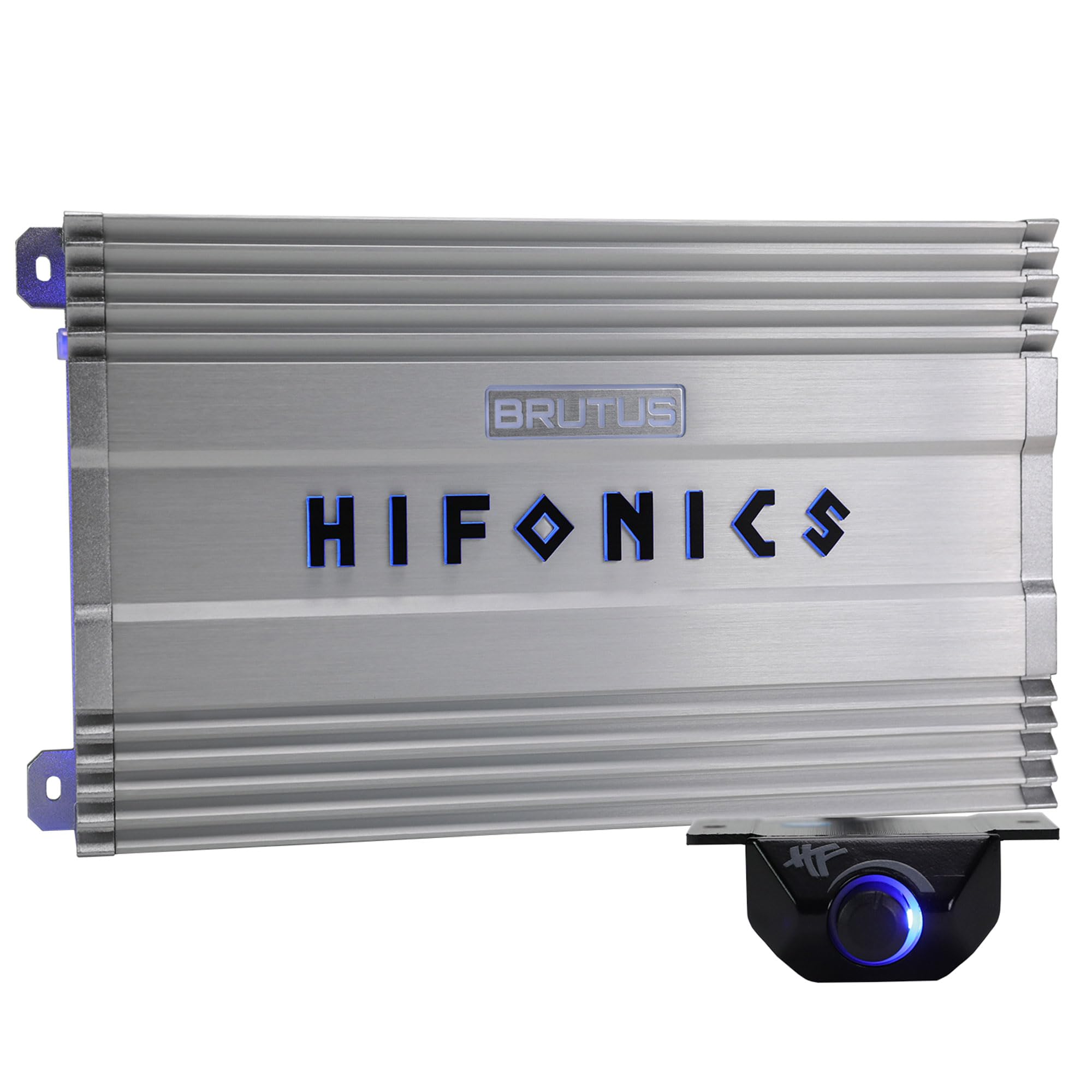Disclosure: This review contains Amazon affiliate links. As an Amazon Associate, we may earn from qualifying purchases—at no extra cost to you.
The Hifonics BG-2200.1D is part of the Brutus Gamma family — a Class-D mono amplifier built for extreme SPL and show applications. In this Hifonics BG-2200.1D review we test real-world RMS output, protection behavior, wiring demands, and whether it’s a practical choice for weekend competition or a daily-driven system that occasionally sees serious volume.

Specs at a Glance (Hifonics BG-2200.1D)
| Power Output | 2200 W RMS @ 1 Ω (nominal spec; see bench results) |
| Amplifier Class | Class-D (Brutus Gamma) |
| Impedance | Stable to 1 Ω (competition wiring) |
| Efficiency | ≈ 82%–86% (depending on load) |
| Dimensions | 13.8″ × 8.1″ × 3.1″ |
| Cooling | Active fans + large heatsink |
Bench Test & Real-World Output
On a regulated bench supply the BG-2200.1D produced clean output approaching its spec under controlled conditions: sustained readings near ~2150–2250 W RMS at 1 Ω before clipping on a clean sine. At 2 Ω the amp still delivered strong power (~1200–1350 W RMS) — numbers that line up with what competitive builders expect from a Brutus Gamma unit. Burst peaks exceeded published RMS numbers as expected during short transients.
Thermal behavior is typical for a high-power monoblock: chassis temps climbed faster than small mono amps but plateaued under proper airflow. The active fan system runs audible under heavy load, but it prevents thermal shutdowns during competition-style bursts.

Wiring, Installation & Protection Notes
The BG-2200.1D requires heavy-duty wiring and a robust electrical system. For real-world competition use we recommend a minimum of 0/1 AWG power & ground, multiple high-rate fuses or an appropriately rated fuse block, and an alternator capable of sustaining high current draw (or a dual-battery setup). Short power runs, tight chassis grounds, and properly sized fusing are mandatory to avoid voltage sag, nuisance protection trips, or worse.
The amp includes protection circuits for thermal, over-current, and DC faults; in practice the protection logic mutes or reduces output gracefully on sustained faults rather than instantly destroying components. Still — proper installation is the first line of defense.
Real-World Tuning, Heat Management & SPL Strategy
For SPL builders, the BG-2200.1D is a tool: it converts a well-fed electrical system into raw mechanical energy at the sub. Tuning is less about subtlety and more about headroom management. Start by ensuring the powertrain (alternator, battery, distribution) supplies stable voltage under load — anything below ~13.0 V under heavy bass will shave peak performance. Use a high-quality voltmeter at the battery and amp during initial bursts to verify stability before final tuning.
Gain staging follows standard practice but with competition priorities: set the head unit or DSP gain to unity, then use a calibrated test tone and oscilloscope or RTA to push the amp to its clean limits. Because the BG-2200.1D tolerates aggressive loads, it’s easy to over-tune. A conservative approach — aiming for clean peaks rather than continuous clipping — preserves both sub and amp life. Bridging multiple amplifiers? Make sure each amp sees the correct impedance and that wiring is balanced between channels to prevent uneven heating.
Heat is the other critical variable. Unlike compact monos that rely solely on passive dissipation, the Brutus Gamma couples a large heatsink with high-velocity fans. When installing, prioritize airflow: mount the amp so fans can intake cool air and exhaust upward or outward; burying it under carpet or against unventilated surfaces reduces thermal headroom and shortens component life. For show vehicles that idle in hot environments, consider supplemental ventilation or timed duty cycles (short bursts, with recovery intervals) to avoid continuous heat soak.
Lastly, speaker and enclosure matching define the usable power. The BG-2200.1D pairs best with competition-grade subs capable of handling huge excursion and power (dual-voice coil, high BL motors). For sealed competition boxes, tuning into low-mid Hz with sturdy cone and spider assemblies yields the biggest SPL without mechanical failure. For everyday drivers wanting occasional show-level bass, fuse the amp conservatively, use quality wiring, and accept that continuous max-rated output is generally reserved for short bursts and competition rounds.
Comparative Notes & Use Cases
Compared with the JD250/1 or JL’s audiophile amps, the Hifonics BG-2200.1D is in a different category: it trades refinement and low noise for brute force and visual impact. Versus the Taramps Big Boss 5 Bass, it competes closely on price/performance but often requires fewer system tweaks to be competition-ready in North American installations.
Pros & Cons
- ✅ Very high real-world RMS for competition builds
- ✅ Robust protection logic and serviceable cooling
- ✅ Excellent value per watt for SPL enthusiasts
- ❌ High current draw — requires pro-level electrical upgrades
- ❌ Fans are audible under heavy load
Best Alternatives to Consider
- JL Audio JD250/1 — audiophile precision over brute force
- Taramps The Big Boss 5 Bass — another high-output SPL option
- 2025 Bass Amp Roundup — compare the full tested field
Final Verdict
The Hifonics BG-2200.1D review finds a competitively priced Brutus Gamma amp that delivers on raw SPL potential. If you’re building a show car or competition rig and have the electrical support to feed it, the BG-2200.1D gives massive, usable power with protection and cooling that keep it reliable in the field — provided the installation is done correctly.
Amazon Disclosure: As an Amazon Associate, we earn from qualifying purchases. Product pricing and availability are accurate at the time of publication and may change.
